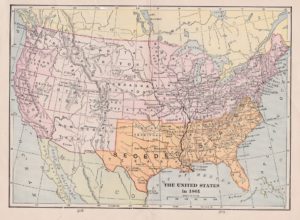All summer, as protests raged over the United States, fears grew that an increasingly polarised United States was heading for another civil war. There was great worry over violence erupting across the land, and a distinct sense that there were at least two rival and distinct Americas in the country: Red America and Blue America. Political movements such as the Lincoln Project and the Wide Awake Boys explicitly made comparisons between the present time and the Civil War-era. Almost two thirds of Americans, in May 2020, believed that the country was close to civil war.

The 2020 presidential election might therefore have the same effect as that of 1860 election: then, the election of Abraham Lincoln as President persuaded the South that a radical politician determined to destroy their way of life had captured the White House, and their only option to maintain their society and values was to secede. Many feared that Trump supporters—and the fear has mainly been focussed on, and derived from, Trump supporters—would react in a similar fashion if, as has happened, Biden won the presidency. With that in mind, we must firstly consider what parallels can be drawn between 1860 and 2020 and whether 1860 is the most useful comparison to make to understand America’s current political moment.
Firstly, the 1860 election revealed a nation deeply politically polarised. In the North, the pro-slavery candidate, John Breckinridge, took only 5% of the vote whilst in the South, the anti-slavery candidate Abraham Lincoln took only 4% (and in some states was not even on the ballot). This was in many ways the results of generations of division that can be traced back to the Nullification Crisis of the 1830s, at the very latest. Similarly, polarisation in 2020 is the result not just of recent policies but also of a generation of voters growing up in one-party households. Secondly, both elections had an issue with ‘fake news.’ Donald Trump’s mendacities have been well documented over the years, and continued throughout the election (most notably, of course, over the legality of mail-in votes). The polarising effect of this and its undermining of democratic norms is exacerbated by social media. Similarly, in 1860 newspapers throughout the South promulgated reports that a Republican victory would incite black against white violence on a vast scale, and that other planks of the Republican platform were radically revolutionary in their design. This helped whip the South into a state of frenzy. Finally, in 2020 as in 1860, this division was most starkly apparent in often violent disputes over the nature of institutional racism.
However, the differences far outweigh the similarities between the two elections. Firstly, we should consider why the South felt it could secede—by which I mean in a practical, rather than a constitutional sense. It had weathered the recent economic recession (or ‘panic’) of 1857 brilliantly, whilst the Northern economy had slumped, reinforcing its sense of superiority. In stark contrast to Trump supporters who want to return the United States to a (probably mythical) past, the antebellum South saw itself as at the peak of its greatness. Additionally, by 1860 there was growing militarisation in the South, often encouraged by state governors and organised at the state level, which does not have a parallel to today. The South also enjoyed the support of a large number of military professionals; Trump has nothing similar. There are, of course, organisations such as the ‘Proud Boys,’ but these are neither organised with state government support nor enjoy the legitimacy, or widespread participation, of state militias in the antebellum era. There is therefore a threat of paramilitary violence, but not of organised, legitimated violence in the sense of putting armies into the field equipped with modern military technology and tactical training, as the South was able to do in 1861. As mentioned above, Lincoln was not even on the ballot in the Lower South in 1860; 2020 is nowhere near that level of democratic malfunction, and indeed, in terms of interference and intimidation the verdict so far has been overwhelmingly positive. Finally, it is true that Trump and his followers are disputing the election (although, in another key difference to 1860, Trump’s supporters are getting fewer by the day). By contrast, secession came about precisely because the South accepted the result of the 1860 election, that Lincoln would be president. Indeed, when it comes to a president refusing to accept the outcome of an election, there is no parallel in US history at all.
Is 1860 the correct parallel to draw? It seems other US elections provide more fruitful comparisons. Perhaps 2020 is closer to 1968, an election held in volatile conditions after a violent summer of riots and protests, between parties deeply polarised not just on political but cultural issues as well. Or perhaps it is closer to 1884, an exceptionally close election in terms of states won and percentage of the popular vote for each candidate, in which the personal character of each candidate was paramount (amid multiple allegations of corruption and sexual assault). Trump probably wishes it was closer to 1844, an election which saw a narrow Democratic win amidst multiple instances of voter fraud.
However, the very uniqueness of Trump’s position surely dictates that we must look for a different sort of parallel—such as the Nullification Crisis mentioned above. In the Nullification Crisis, the economy of South Carolina was adversely affected by the Tariff of 1828, and in response, its chief political leader, John C. Calhoun, came up with the doctrine of ‘nullification’: a state could nullify or abolish any federal law that harmed it. When the government of Andrew Jackson refused to accept this, Calhoun formulated a new doctrine of secession: that any state that did not agree with federal policy had a legal and moral right to secede and claim independence. This was the first time, in 1832, that South Carolina threatened secession, but wiser heads and Federal threat of force ultimately prevailed to maintain the union. However, that idea had become a political possibility, and a generation later it became political fact. Trump has raised several political possibilities in the course of his administration, not least disputing election results if he happens to disagree with them, and even if no one explores them now, politicians in the future may take encouragement from them, especially if the nation continues down its path of polarisation. Most worrying of all are the parallels that may be drawn from outside American history.
In conclusion, in the short term, the United States is almost certainly not on track for civil war. However, Trump has made the idea of disavowing election results a political possibility, just as South Carolina made the idea of southern secession a political possibility over the Nullification Crisis. The Union, for now, will endure; in the long term, however, its stability will greatly depend on how many consider him a warning, and how many consider him an inspiration.






